Microbial Biogeography Blog!
What are microbes?A microbe is a category of organism that is so small to be seen by the naked eye. There are five main types of microbes, which include bacteria, viruses, fungi, algae and protozoa.
What are bacteria?
Bacteria are microscopic single-celled organisms that thrive in diverse environments.
What shape are bacteria?
There are three main shapes of bacteria, and they are coccus (spherical), bacillus (rod-shaped), and spiral (twisted).
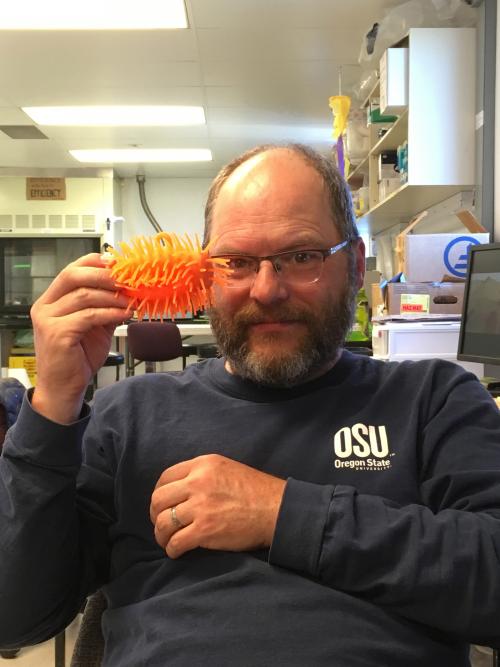 Dr. Byron Crump with a DYI microbe my Wonderkids students made. Photo by DJ Kast
Dr. Byron Crump with a DYI microbe my Wonderkids students made. Photo by DJ Kast
How big are bacteria?
TINY!
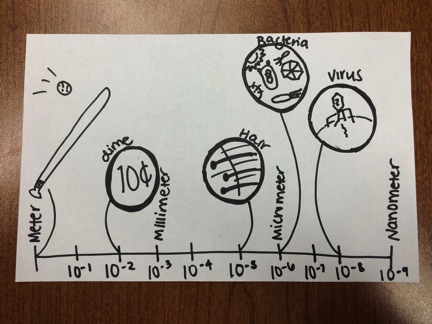 How big are microbes? Photo by DJ Kast
How big are microbes? Photo by DJ Kast
Arctic Microbes
- Microbes are everywhere in the natural world
- Microbes eat soil carbon and breathe out CO2
- The rate of this CO2 production depends on which microbes are there and whether they have the ability to convert soil carbon into CO2
- Each environment has its own distinct bacteria like in lakes and streams that have different genetic capabilities to convert soil carbon into CO2
Microbes are everywhere in our environment. They are on us, inside us, and many organisms have their own microbial community just like us.
Microbial environmental changesMost microbes are decomposers and specifically in the Arctic most of them eat soil carbon and breathe out carbon dioxide. The rate of this depends on which microbes are where.
The permafrost (frozen soil) represents a freezer filled with bacteria food, and as the temperatures get warmer the food starts the thaw. The microbes love the thawed food, they consume it and then let CO2 out just like us humans.
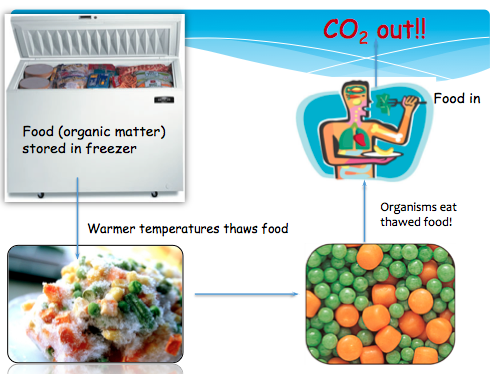 How microbes process the permafrost soil carbon. Photo by DJ Kast, slide by Dr. Rose Cory
How microbes process the permafrost soil carbon. Photo by DJ Kast, slide by Dr. Rose Cory
Every environment you can think of has its own distinct bacteria that define their particular habitat – so there are soil bacteria, and lake bacteria, and gut bacteria, etc.
Microbes are indicators of environmental change because the diversity or kinds of microbes changes in response to environmental changes.
The Dr. Crump lab research questions really come down to: Which bacteria are consuming the most CO2 in different locations? Bacteria populations have different eaters too like us some are vegan, some eat meat and potatoes and no veggies, some eat only meat. So we are looking at which types of bacteria are consuming carbon and quantifying how much CO2 is given off.
Arctic Crime Scenes- Who is there and what are they doing?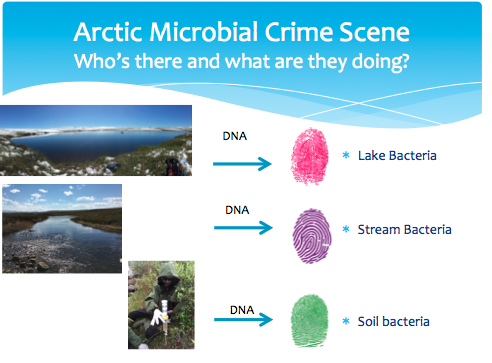 Dr. Crump's lab figures out how to identify with the DNA the types of bacteria that are from lakes, streams and soils and how they contribute to climate change. Photo by DJ Kast
Dr. Crump's lab figures out how to identify with the DNA the types of bacteria that are from lakes, streams and soils and how they contribute to climate change. Photo by DJ Kast
Microbes are the who has done it of climate change in the Arctic. They are converting that Soil carbon into CO2 but different habitats have unique fingerprints through the lens of microbe diversity. Streams, Lake and Soil bacteria are very different but are defined by a fingerprint that defines that community. These fingerprints are defined through DNA. These habitats are connected, so Dr. Crump’s team is trying to see how these communities interact as different types wash down the watershed.
How microbe populations change across the landscape.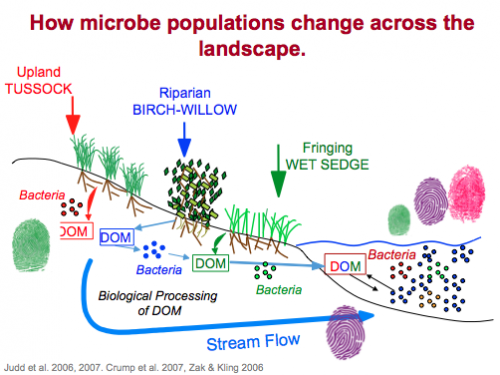 How microbe communities change across the landscape. Slide from Dr. Crump, additional fingerprints made by DJ Kast
How microbe communities change across the landscape. Slide from Dr. Crump, additional fingerprints made by DJ Kast
As the microbes travel down the watershed, they go through various habitats associated with different streams. You will find a combination of them ending up in the Lake.
Bacteria in soils do turn soil carbon into CO2. Once they get into lakes and streams do they continue to do that since there are different conditions in lakes and streams such as temperature, pH, water chemistry etc. Can these lake bacteria continue doing what they were doing in the soils.
I-series
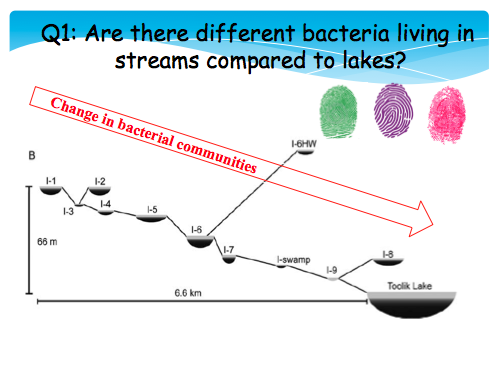 I-series figure of connected lakes. Figure by Dr. Crump, additions by DJ Kast
I-series figure of connected lakes. Figure by Dr. Crump, additions by DJ Kast
The I-series lakes showing how water slows between the lakes and streams. The black pits are lakes and the lines are streams. The question here is: Are there different bacteria living in streams compared to lakes?
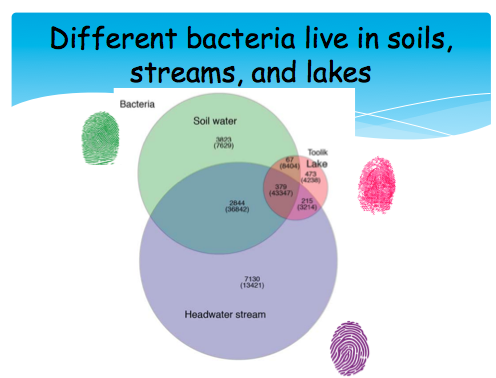 Different bacteria live in soils, streams, and lakes but there is overlap. Figure by Dr. Crump, Photo by DJ Kast
Different bacteria live in soils, streams, and lakes but there is overlap. Figure by Dr. Crump, Photo by DJ Kast
Important thing is that the streams are continuously bringing in the soil bacteria. I've seen first hand since the streams are brown and the lake is blue. It’s important to know that they are connected. It’s the bacteria and soil carbon is replenished and then sent further downstream where more soil comes in and gets into the next lake and so on and so forth.
Are there different bacteria living in streams compared to lakes?
Answer! Yes there are different bacteria that live in lakes and streams but there is overlap between the two, as with soil water also.
Bacteria Surveys
Dr. Crump’s lab is demonstrating this microbe ID changing across the watershed on different scales. The bacteria survey is a very large-scale version of what the I-series is accomplishing. The I-series measures a Small change over couple kilometers for versus the 6-20 miles away for bacteria survey.
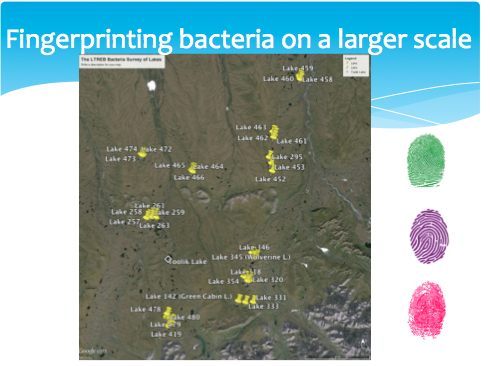 Bacteria Survey sites. Figure by Dr. Crump, photo by DJ Kast
Bacteria Survey sites. Figure by Dr. Crump, photo by DJ Kast
The bacteria survey is a two-day survey of 36 lakes in the Arctic Tundra. These 36 Lake sampling spree is done to address their question of connectivity on the landscape and how it can influence the types of bacteria in the lake further down the watershed.
Collecting our microbial criminalsIn the field, water is collected in both the lakes and streams. Just the water is not enough for us to be able to isolate the bacteria that we want to ID.
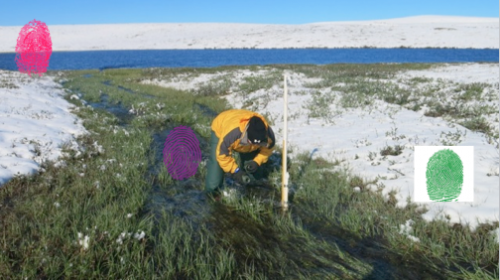 Identifying the sources of stream, lake and soil bacteria while collecting water samples. Photo by DJ Kast
Identifying the sources of stream, lake and soil bacteria while collecting water samples. Photo by DJ Kast
We process the water samples we have by filtering them with a very small filter that catches the bacteria and sends out the water.
Fingerprinting microbes with their DNA in the Lab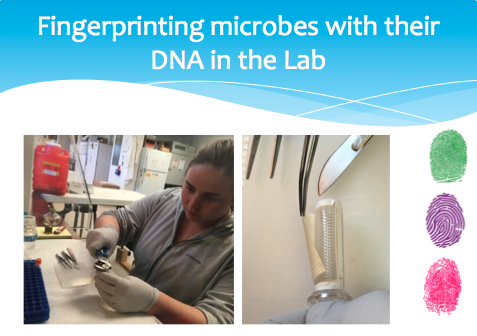 Fingerprinting microbes with their DNA in the lab. Photo by DJ Kast
Fingerprinting microbes with their DNA in the lab. Photo by DJ Kast
When the sterivex filters are in the lab, they are processed by being opened, and the filter paper is removed and cutup to smaller sizes. Johanne (Dr. Crump’s research assistant goes through several steps to extract the DNA from the filters. These tubes are then sent to Crump’s lab where they are processed, DNA amplified so that they have lots of copies and then sent for sequencing. Dr. Crump does this so that he can quantify the types of bacteria found in each of the water samples representing each of the lakes and streams to address the water connectivity research question.
How does DNA help us identify microbes?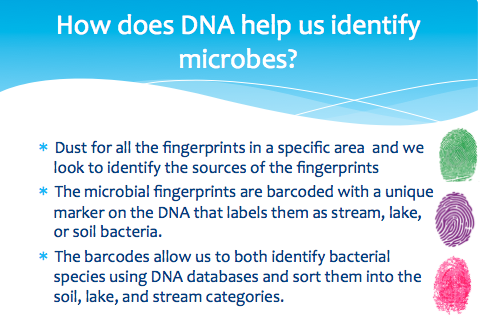 DNA helps us identify microbes! Photo by DJ Kast
DNA helps us identify microbes! Photo by DJ Kast
- Dust for all the fingerprints in a specific area and we look to identify the sources of the fingerprints
- The microbial fingerprints are barcoded with a unique marker on the DNA that labels them as stream, lake, or soil bacteria.
- The barcodes allow us to both identify bacterial species using DNA databases and sort them into the soil, lake, and stream categories.
The permafrost is thawing and dumping carbon into the lake and the microbes in the lake able to convert it to CO2. This will be happening more and more. We know they can because by studying the specific species of bacteria and where they come from, we have been able to show that the bacteria come from the soil and bring with them the genetic capability to convert soil carbon into carbon dioxide.
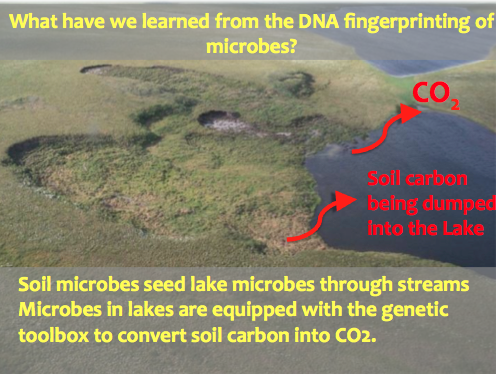 Soil microbes seed lake microbes that can still convert carbon dioxide. Slide content provided by Dr. Rose Cory
Soil microbes seed lake microbes that can still convert carbon dioxide. Slide content provided by Dr. Rose Cory
Microbes in the soils seed microbes in streams and lakes.
The microbes in the streams and lakes have the genetic capabilities to turn permafrost carbon into CO2 as more and more of this permafrost carbon is moved from soils to streams to lakes.
As great as it sounds that Dr. Crump’s lab has discovered this, its not a good thing because it adds to our positive feedback loop of more permafrost (or frozen carbon) thawing, more CO2 and other heat trapping gases like methane being created through the microbes, and continuing the greenhouse gas emissions that are warming the planet and causing further damage to the Earth.
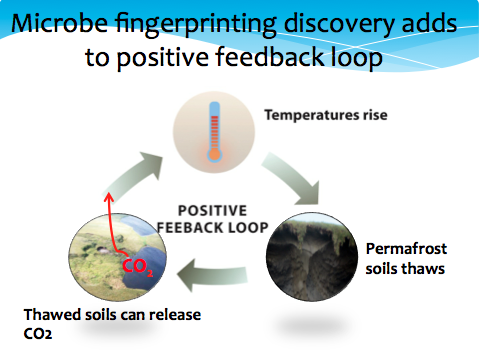 Permafrost thawing feedback loop. Slide content provided by Dr. Rose Cory, photo by DJ Kast
Permafrost thawing feedback loop. Slide content provided by Dr. Rose Cory, photo by DJ Kast

Comments
Add new comment